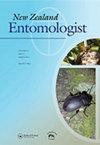Can native plantings encourage native and beneficial invertebrates on Canterbury dairy farms?
IF 0.4
4区 农林科学
Q4 ENTOMOLOGY
引用次数: 7
Abstract
ABSTRACT Farming intensification negatively effects native habitat and associated biodiversity in New Zealand. Planting native species around field margins has been proposed as a means of restoring biodiversity within this highly modified landscape. To test this hypothesis, we collected invertebrates on a dairy farm at Lincoln, Canterbury, in three habitat types: native plantings in field corners, native plantings along a double fence line, and pasture. Invertebrates were collected from pitfall traps, yellow pan traps, wooden discs and leaf litter samples were collected from the sites over summer. Assemblages of spiders, flying insects, slugs and litter mites in the planted areas had distinct compositions compared with those found in adjacent pasture. Species richness of native spiders was increased in the planted areas compared with adjacent pasture, as was the abundance of ecosystem service providers, such as honeybees, parasitoid wasps and hoverflies. Exotic slugs were significantly more abundant under discs in pasture than in planted areas. However, not all native or beneficial invertebrates responded positively to the planted areas. Further research is required to examine whether these results are repeatable at other locations, if invertebrate assemblages at this location develop further over time, and to evaluate whether any perceived benefits of these service providers can be quantified in terms of meaningful endpoints such as reduced pest levels and/or increases in yield.本地种植能否鼓励坎特伯雷奶牛场的本地和有益的无脊椎动物?
农业集约化对新西兰原生生境和相关生物多样性产生负面影响。在这片高度改变的土地边缘种植本地物种是恢复生物多样性的一种方法。为了验证这一假设,我们在坎特伯雷林肯的一个奶牛场收集了三种栖息地类型的无脊椎动物:田间角落的原生植物,沿着双栅栏线的原生植物和牧场。无脊椎动物在夏季通过陷阱、黄盘陷阱、木盘和落叶样收集。种植区内的蜘蛛、飞虫、鼻涕虫和凋落物螨的组成与邻近牧草区明显不同。与邻近牧场相比,人工区原生蜘蛛的物种丰富度有所增加,蜜蜂、寄生蜂和食蚜蝇等生态系统服务提供者的丰富度也有所增加。牧草区圆盘下外来蛞蝓数量明显高于种植区。然而,并不是所有的原生或有益的无脊椎动物都对种植区域有积极的反应。如果该地点的无脊椎动物种群随着时间的推移进一步发展,需要进一步的研究来检验这些结果在其他地点是否可重复,并评估这些服务提供商的任何可感知的好处是否可以通过有意义的端点来量化,例如降低害虫水平和/或增加产量。
本文章由计算机程序翻译,如有差异,请以英文原文为准。
求助全文
约1分钟内获得全文
求助全文
来源期刊

New Zealand Entomologist
ENTOMOLOGY-
CiteScore
0.70
自引率
33.30%
发文量
3
审稿时长
>12 weeks
期刊介绍:
The invertebrate diversity of New Zealand is of great interest worldwide because of its geographic isolation and geological history. The New Zealand Entomologist plays an important role in disseminating information on field-based, experimental, and theoretical research.
The New Zealand Entomologist publishes original research papers, review papers and short communications. We welcome submissions in all aspects of science regarding insects and arthropods in a New Zealand or Australasian setting. The journal’s subject matter encompasses taxonomy, phylogenetics, biogeography, biological control and pest management, conservation, ecology and natural history.
The journal is the official publication of the Entomological Society of New Zealand. Papers published or submitted elsewhere for publication will not be considered, but publication of an abstract or summary elsewhere (e.g. conference proceedings) does not preclude full publication in the New Zealand Entomologist. Accepted papers become copyright of the Entomological Society of New Zealand. The journal is published in English, but we also welcome publication of abstracts in Maori.
 求助内容:
求助内容: 应助结果提醒方式:
应助结果提醒方式:


